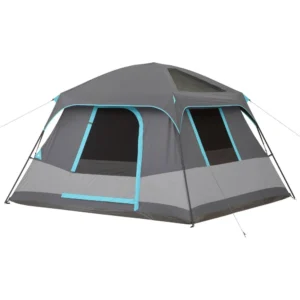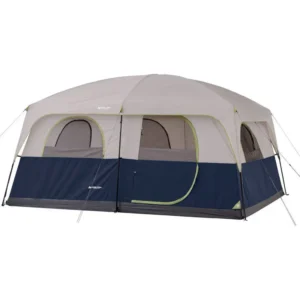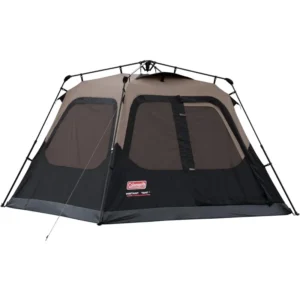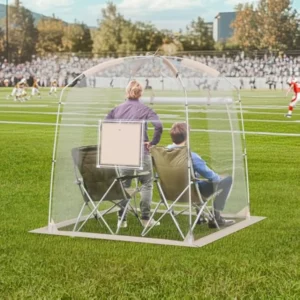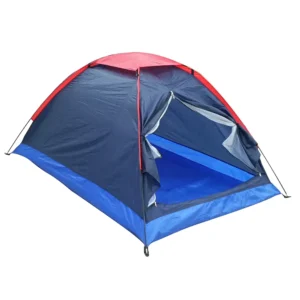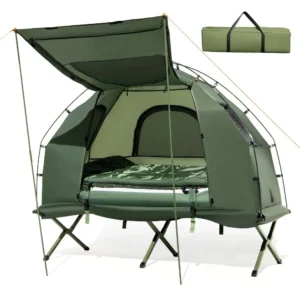Understanding Tent Height for Enhanced Camping Experience
When you’re planning an extended camping trip, few things can impact your comfort as much as whether you can stand up straight in your tent. A standing-height tent—generally considered to be at least 6 feet (72 inches/183 cm) tall—can completely transform your outdoor experience.
Tent height matters significantly because it directly affects how you move, organize, and live in your temporary home. Many campers don’t realize how frustrating it can be to spend days hunched over or crawling around until they’ve experienced it firsthand. This discomfort becomes especially apparent during activities like changing clothes or waiting out bad weather.
What many tent buyers misunderstand is the difference between peak height and usable space. The advertised height measurement typically refers only to the tallest point in the tent, not the overall area where you can stand comfortably.
In this guide, we’ll explore the ideal tent heights for different campers, compare tent designs for maximum standing room, and help you understand the balance between comfort and practicality when selecting a tent where shelter options for two campers or more allow comfortable standing. We’ll also look at the range of tall stand-up camping tents available for different camping styles and circumstances.
The Benefits of a Standing-Height Tent
Choosing a tent that allows you to stand upright delivers numerous practical advantages that significantly enhance your camping experience:
- Easier dressing and changing clothes: Rather than awkwardly squirming into your pants while lying down, you can change naturally as you would at home.
- Improved comfort during extended stays: The longer your camping trip, the more you’ll appreciate being able to stretch fully and move around normally.
- Better gear organization: Standing height allows you to properly sort, find, and organize your equipment without sprawling everything across the tent floor.
- Reduced confinement during bad weather: When rain forces you inside for hours or even days, being able to stand and move around freely helps prevent “cabin fever.”
- Enhanced family camping experience: Parents can comfortably assist children with dressing, playing games, or managing bedtime routines.
- Improved air circulation: The increased volume allows for better airflow, reducing condensation and creating a healthier environment.
During a weeklong family camping trip when consecutive rainy days keep everyone tent-bound, the difference between a standing tent and a crawl-in dome becomes painfully obvious. In low-height tents, simple tasks like getting dressed become complex gymnastics exercises, while standing tents allow normal movement and activities.
The importance of adequate height is often overlooked when preparing for two-person lightweight tent setup, but becomes immediately apparent once you’re at the campsite.
Peak Height vs. Usable Standing Room: What’s the Difference?
One of the most common misconceptions in tent shopping is assuming that the advertised “peak height” represents the overall height throughout the tent. In reality, peak height only measures the single tallest point—usually the center—while the actual standing area varies dramatically based on tent design.
The slope of the tent walls critically determines how much of the interior space is actually usable for standing. Consider how different tent designs affect standing room:
Dome Tents: Despite a reasonable peak height (often 5-6 feet), dome tents have aggressively curved walls that severely limit the standing area to a small circle in the center. A 6-foot person might only be able to stand upright in 10-15% of the tent’s floor space.
Cabin Tents: With nearly vertical walls, cabin tents maximize usable height throughout the interior. A 6-foot peak height in a cabin tent might allow standing in 70-80% of the floor area, making them ideal for comfortable movement.
Tunnel Tents: These provide good headroom along the central ridge but slope down on the sides. A tunnel tent with 6.5-foot peak height typically allows standing along the center corridor, representing about 40-50% of the interior.
Bell/Tipi Tents: These feature excellent central height but steeply sloping sides. Standing is comfortable in the middle 30-40% of the tent but impossible near the edges.
Entry height is another crucial but often overlooked factor. Even if a tent offers good interior standing height, a low door forces you to duck or crawl every time you enter or exit—significantly reducing convenience.
When evaluating tent options, understanding these design differences helps explain why campers with tall tents for camping report vastly different comfort levels, even when peak heights appear similar on paper.
Recommended Tent Heights Based on User Height
Finding the right tent height requires matching the tent to your specific needs. While 6 feet (72 inches/183 cm) is the minimum threshold for basic standing, the ideal height varies depending on the user’s height and desired comfort level.
| Camper Height | Minimum Tent Height | Recommended Tent Height | Additional Considerations |
|---|---|---|---|
| Under 5‘6” (168 cm) | 5‘10” (178 cm) | 6‘6” (198 cm) | Standard cabin or tunnel tents work well |
| 5‘6”-6’ (168-183 cm) | 6‘2” (188 cm) | 6‘8” (203 cm) | Look for steep walls, adequate floor length |
| Over 6’ (183 cm) | 6‘6” (198 cm) | 7’ (213 cm) | Prioritize vertical walls, check floor length (90”+/229+ cm) |
For comfortable movement rather than just standing in place, add at least 4-6 inches (10-15 cm) to these minimum heights. This extra space allows for natural movement without constantly monitoring your head position.
Camping duration also affects height needs. For weekend trips, you might tolerate slightly less headroom, but for extended camping, the additional comfort of generous standing space becomes increasingly valuable.
Families with varied heights should consider the needs of the tallest member. A family with teens might need to prioritize greater height than they initially anticipated, as several inches of extra headroom can make the difference between a comfortable space and constant ducking.
Best Tent Types for Maximum Standing Room
Different tent designs offer varying amounts of usable standing space. Here’s how the major tent types compare:
Cabin Tents
* Pros: Nearly vertical walls maximize standing area; many models feature room dividers with standing height throughout
* Cons: Heavier, bulkier when packed; less stable in strong winds
* Best for: Family camping, base camping, extended stays
* Standing area: 70-80% of floor space typically usable at full height
Tunnel Tents
* Pros: Good standing height along the center ridge; excellent space-to-weight ratio
* Cons: Less standing room near sides; requires proper staking and guying
* Best for: Balancing comfort with some portability; group camping
* Standing area: 40-50% of interior typically at full standing height
Bell/Canvas Tents
* Pros: Excellent central height (often 7+ feet); traditional aesthetic; good ventilation
* Cons: Heavy; sloped sides reduce usable space; longer setup time
* Best for: Glamping, extended stays, aesthetic-focused camping
* Standing area: 30-40% of interior at standing height (central area)
Large Dome Tents
* Pros: Better wind stability; lighter than similarly sized cabin tents
* Cons: Limited standing area even in larger models; curved walls reduce usable space
* Best for: Camping in windy conditions where stability matters
* Standing area: 10-20% of floor space at full height (central area only)
Instant/Pop-up Cabin Tents
* Pros: Combine standing height with super-fast setup; often feature cabin-style walls
* Cons: Typically heavier; may be less durable over long term
* Best for: Convenience-focused campers; weekend trips
* Standing area: 60-70% of interior at standing height (model dependent)
When evaluating dome camping tents, pay special attention to the height-to-width ratio, as this significantly affects the standing area.
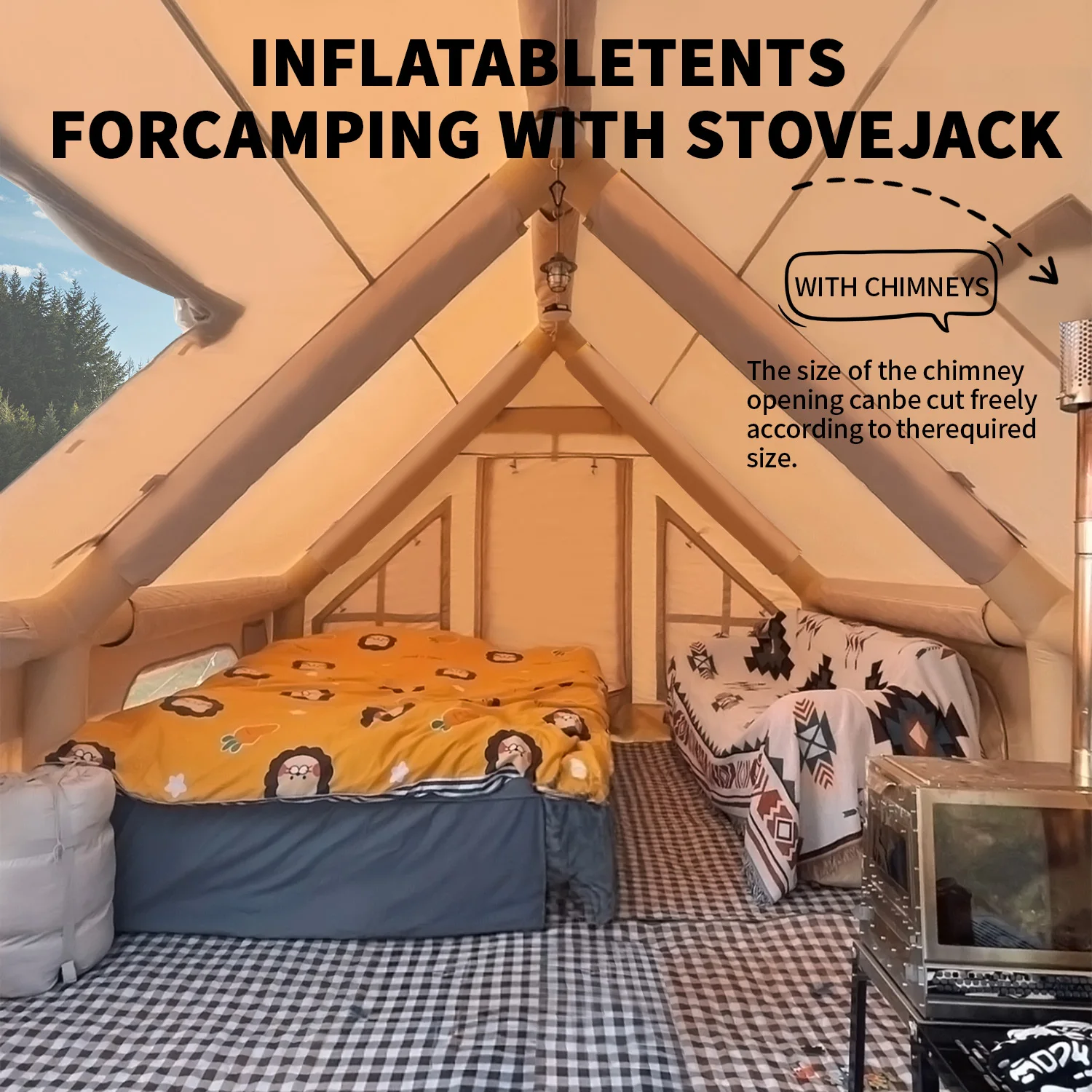
Key Factors Beyond Peak Height for Comfortable Standing
While peak height is important, several other factors significantly impact the comfort of standing in a tent:
Floor Dimensions: A tent might have adequate height but insufficient floor space to move around comfortably. For standing comfort, look for floor dimensions that allow you to walk a few steps in at least one direction.
Actual vs. Rated Capacity: Manufacturer capacity ratings typically assume minimal personal space. For comfortable standing room with gear, choose a tent rated for 1-2 more people than your actual group size.
Wall Angles: The steeper the walls, the more usable volume a tent provides. A 7-foot peak height with nearly vertical walls offers dramatically more usable space than the same peak height with aggressively sloped walls.
Interior Layout: Features like room dividers, internal support poles, and gear lofts can impact where you can stand comfortably. Center room dividers in particular should maintain adequate height if you want standing room in both sections.
Ventilation Design: Taller tents require proper ventilation to prevent condensation buildup in the larger volume of air. Look for high and low vents to create effective airflow.
Weight and Packability: Standing-height tents average 20-30 pounds (9-14 kg), compared to 5-10 pounds (2-4.5 kg) for backpacking models. Consider how you’ll transport the tent and whether the comfort justifies the additional weight.
Setup Complexity: Taller tents generally have more complex pole structures and may require multiple people for setup. Some modern easy setup camping tents offer standing height with simplified assembly.
Understanding what size tent is good for 2 people helps with these considerations, though standing tents typically accommodate more than two campers.
How to Test and Choose a Standing-Height Tent
Finding the perfect standing tent requires deliberate evaluation, whether shopping in person or online:
When testing in-store:
* Enter display models completely and stand up straight at various points
* Move around inside to assess the usable standing area
* Check if you can stand comfortably near walls and doorways, not just center
* Test the door height by walking through normally without ducking
When shopping online:
* Look beyond peak height—search for “near-vertical walls” or “cabin-style”
* Check detailed measurements including floor dimensions and wall height
* Read reviews specifically mentioning standing room and comfortable height
* Look for interior photos showing people standing in different areas of the tent
Key questions to ask retailers:
* “What percentage of the floor area allows for standing at full height?”
* “How tall is the doorway compared to the peak height?”
* “Does the tent maintain good headroom throughout or just at the center?”
Pay attention to specific phrases in reviews like “could stand everywhere except near the walls” or “only the center has full height,” which provide valuable real-world insight into the actual standing experience.
Two-room camping tents often provide excellent standing height throughout both sections, making them worth special consideration for families.
Weather Considerations for Taller Tents
Taller tents provide wonderful interior comfort but face unique weather challenges that require special attention:
The increased surface area of tall tents creates greater wind resistance, making them more vulnerable in stormy conditions. Look for features that enhance stability:
* Reinforced pole structures with additional cross-bracing
* Heavy-duty stakes and extra guy-out points
* Double-wall construction for better structural integrity
Site selection becomes critical with taller tents. Whenever possible:
* Choose locations with natural windbreaks like trees or terrain features
* Position the tent with the lowest profile facing into prevailing winds
* Ensure all guy lines are properly tensioned in a balanced pattern
Seasonal considerations also matter significantly:
* Summer camping allows for prioritizing height and ventilation
* Winter camping may require compromising on standing height for better stability in snow and wind
* Three-season taller tents should have adequate rainfly coverage to prevent water entry at higher seams
Rain management deserves special attention in taller designs:
* Look for extended rainflies that cover most of the tent body
* Check that upper seams are properly sealed or taped
* Consider additional waterproofing treatment for tall sidewalls
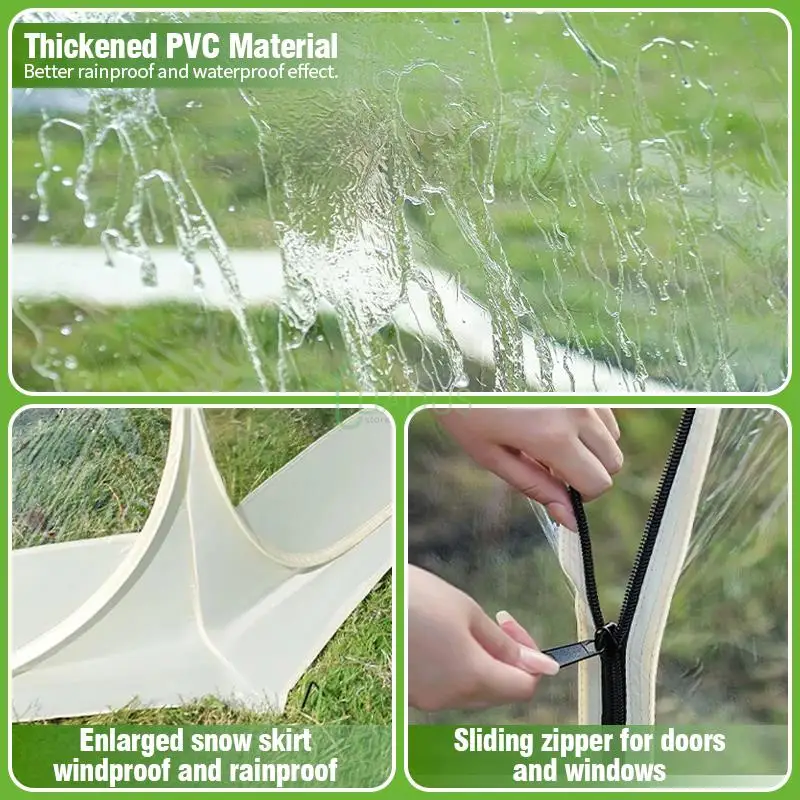
Standing Height Tents for Different Camping Styles
Different camping approaches demand different compromises between standing height and other features:
Family Camping: Prioritize maximum standing room and separate living spaces. Cabin-style tents with 6.5-7 foot (198-213 cm) heights and room dividers create the most home-like experience. The extra weight is rarely an issue since you’ll likely camp near your vehicle.
Base Camping: For longer stays at a single site, standing height greatly enhances comfort. Look for durable cabin or tunnel designs with adequate weather protection and 6.5+ foot (198+ cm) center height. The ability to move naturally during extended periods makes the weight trade-off worthwhile.
Festival Camping: Easy setup combined with standing height makes instant camping tents particularly valuable. The ability to quickly change clothes and organize gear in a comfortable space enhances the festival experience.
Tall / Stand Up Camping Tent, Two Room Camping Tent
$407.93 Select options This product has multiple variants. The options may be chosen on the product page- $476.52 Select options This product has multiple variants. The options may be chosen on the product page
Easy Setup Camping Tent, Instant Camping Tent
Instant Cabin Tent Double Layer Canvas 1-Minute Setup Spacious Family Camping Shelter with Air Vents$308.10 Select options This product has multiple variants. The options may be chosen on the product pageEasy Setup Camping Tent, Trekking Pole Backpacking Tent
$142.40 Select options This product has multiple variants. The options may be chosen on the product pageEasy Setup Camping Tent, Waterproof Camping Tent
All-in-One Elevated 1-Person Camping Tent Cot with Integrated Sleeping System for Outdoor Adventures$535.16 Select options This product has multiple variants. The options may be chosen on the product page
Lightweight Camping: Traditional backpacking rarely accommodates standing height due to weight constraints. However, some larger backpacking tents offer sitting height (approximately 42-48 inches/107-122 cm), which provides a middle ground when weight matters.
Winter/Extreme Weather Camping: Standing height must sometimes be sacrificed for stability. Consider hybrid designs with reinforced pole structures that maintain 5.5-6 foot (168-183 cm) height while withstanding harsh conditions.
Finding the right balance for your specific needs often means weighing the importance of standing comfort against other priorities like weight, setup complexity, and weather resistance. The ultimate guide to tall camping tents offers additional insights into specialized options.
Frequently Asked Questions About Tent Height
Is a 5-foot tent tall enough to stand in?
No, a 5-foot (152 cm) tent isn’t tall enough for most adults to stand upright. It would only accommodate standing for people under 4‘10” (147 cm). Most adults need at least 6 feet (183 cm) for comfortable standing.
What size tent do I need for 2 adults to stand comfortably?
For two adults to have adequate standing room, look for a 6-person rated tent with at least 6‘6” (198 cm) peak height and near-vertical walls. This provides sufficient space for both standing and moving around with gear.
Are there lightweight backpacking tents with standing room?
True standing-height backpacking tents are extremely rare. Some ultralight options like pyramid tents offer center heights around 5‘6”-5‘10” (168-178 cm), which allows limited standing for shorter individuals while keeping weight manageable.
How does tent height affect stability in wind?
Taller tents catch more wind and generally have lower stability in stormy conditions. Cabin-style tents with vertical walls are particularly vulnerable. Compensate with extra guy lines, proper staking, strategic site selection, and positioning the lowest profile toward prevailing winds.
Can tall people (6‘5”+/196 cm+) find tents with adequate standing room?
Yes, several cabin and tunnel tent models offer heights of 7’+ (213+ cm). Very tall campers should prioritize vertical wall designs and also check floor length (90+ inches/229+ cm) to ensure comfortable sleeping.
Do standing-height tents take longer to set up?
Traditionally yes, but modern designs have significantly improved. Many instant or quick-pitch cabin tents with standing height can be set up in under 5 minutes, though they’re still generally more complex than small dome tents.
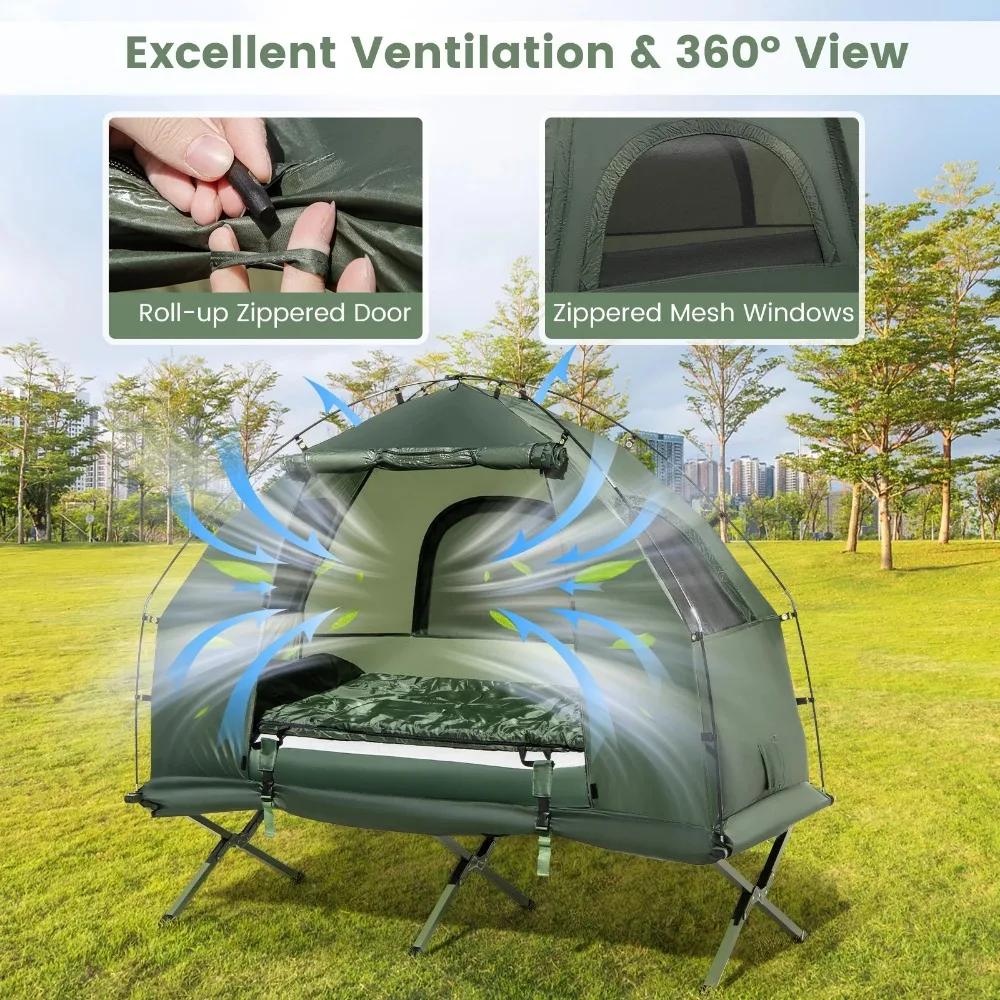
Comfort vs. Practicality: Finding Your Perfect Height Balance
After exploring the importance of tent height, it’s clear that finding your ideal balance between standing comfort and practicality comes down to your specific camping priorities.
For most weekend family campers staying near their vehicles, the benefits of standing height far outweigh the drawbacks. The convenience of normal movement, easier dressing, and better organization makes the additional weight and bulk worthwhile. In these cases, cabin-style tents with heights of 6‘6” to 7’ (198-213 cm) and near-vertical walls create the most comfortable experience.
For those balancing comfort with some degree of portability, tunnel tents or hybrid designs provide a sensible middle ground. These models offer standing height along their center line while remaining more packable than full cabin designs. Choosing the ultimate compact shelter for two often means finding this balance.
When weight and packability become paramount concerns—like for backpacking or remote camping—accepting limited headroom becomes necessary. In these situations, focus on designs that at least allow comfortable sitting height and efficient interior organization.
Weather expectations should also influence your decision. In consistently mild conditions, maximizing interior height improves the camping experience. For variable or harsh weather, compromising some standing room for better stability may be the wiser choice.
Ultimately, the ideal tent height isn’t just about the numbers—it’s about how that height enhances your overall camping experience. By understanding the true impact of usable standing space and matching it to your specific camping style, you’ll make a choice that provides the right balance of comfort and practicality for your outdoor adventures.


